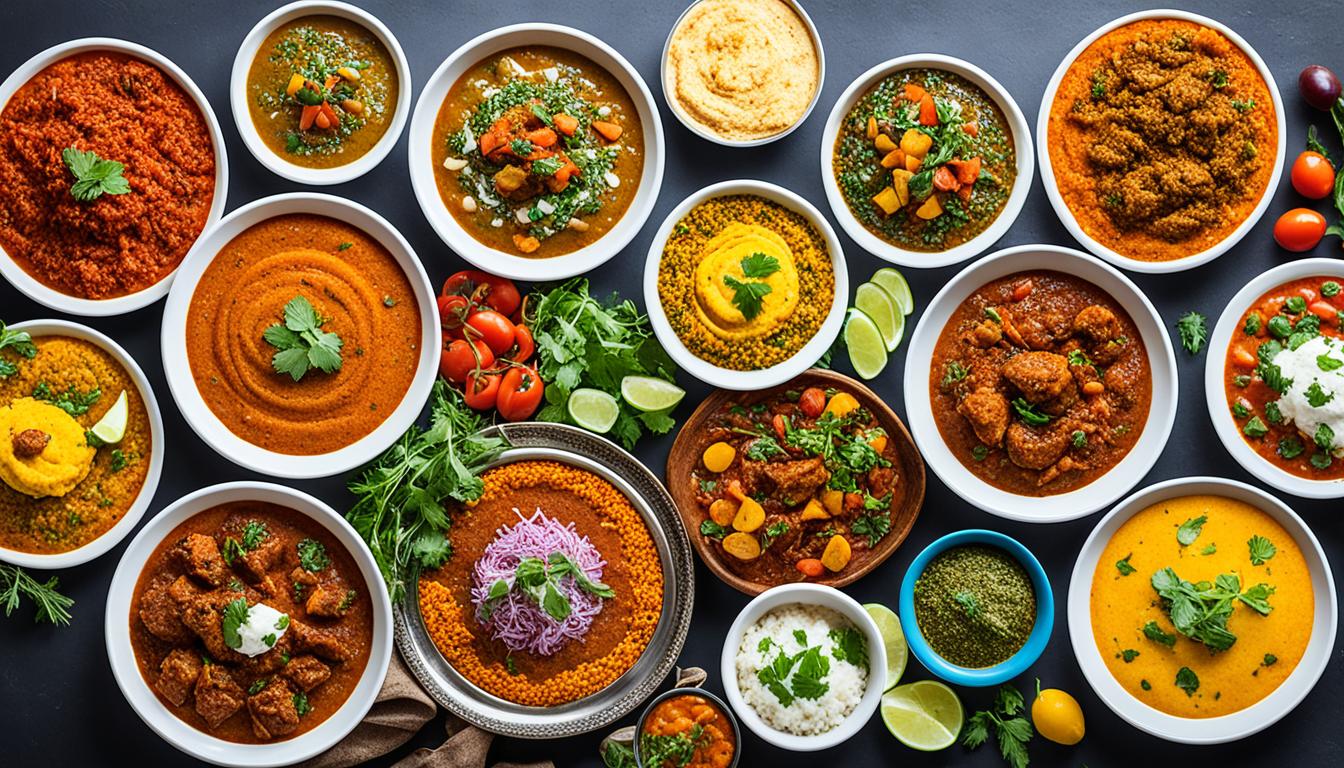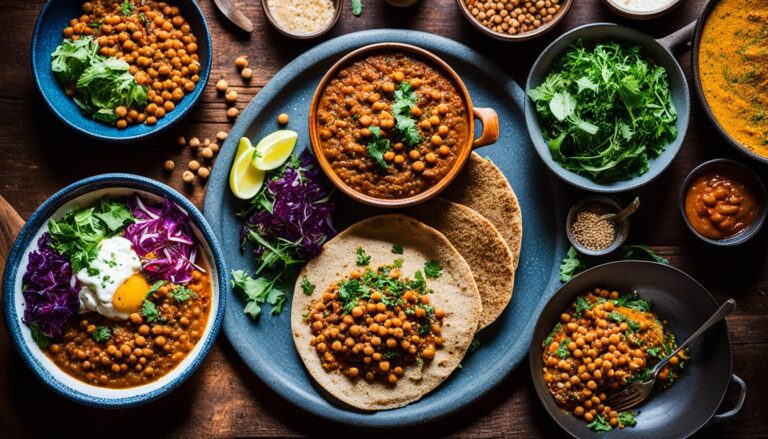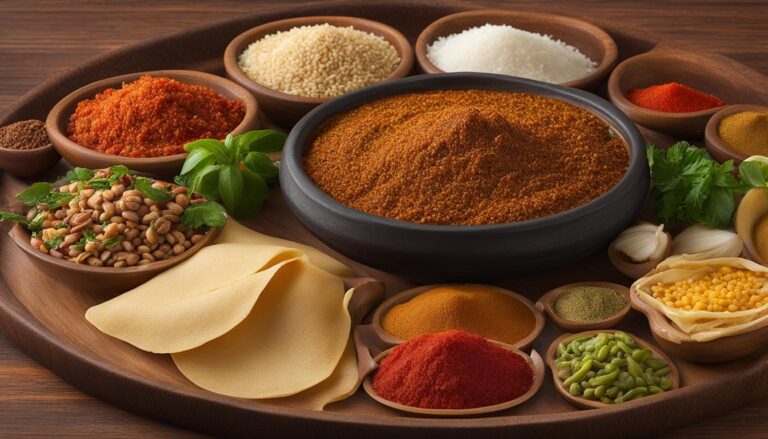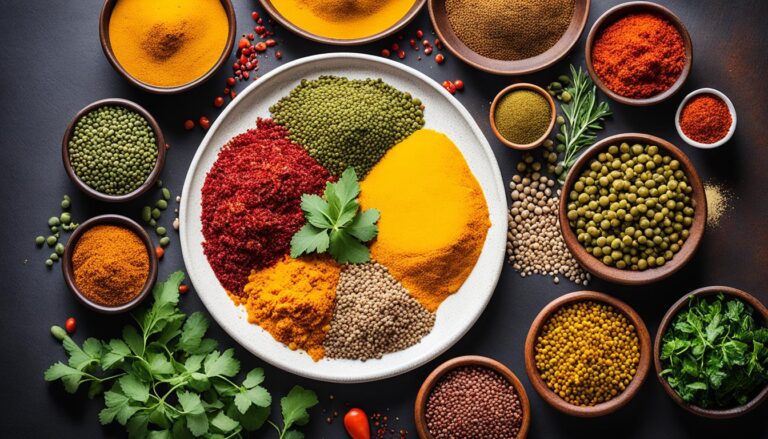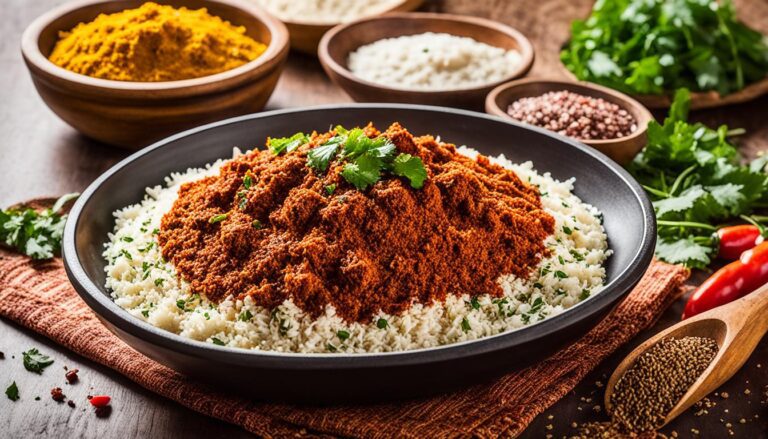How Many Calories in Ethiopian Food?
Welcome to our exploration of Ethiopian cuisine, where we will uncover a fascinating aspect of this vibrant and flavorful food tradition. Have you ever wondered how many calories are in Ethiopian food? Are you curious if it aligns with your dietary goals? Join us on a culinary journey through the nutritional aspects of Ethiopian dishes to discover the answer.
Key Takeaways:
- Ethiopian food is known for its rich culinary tradition and unique flavors.
- Understanding the nutritional profile of Ethiopian dishes can help determine their caloric content.
- Traditional Ethiopian dishes can vary in calorie count based on ingredients and cooking methods.
- Exploring popular Ethiopian dishes and their caloric content can aid in making informed food choices.
- While enjoying Ethiopian cuisine, it is important to maintain a balanced diet.
Ethiopian Food: A Culinary Journey
Before we dive into the caloric content of Ethiopian food, let’s take a moment to appreciate the rich culinary tradition that it represents. Ethiopian cuisine is known for its unique blend of spices, vibrant colors, and distinct flavors. From injera, a sourdough flatbread, to doro wat, a spicy chicken stew, Ethiopian dishes offer a diverse and exciting culinary journey.
Exploring the Nutritional Profile of Ethiopian Food
Understanding the nutritional profile of Ethiopian food is key to determining its caloric content and making informed dietary choices. Ethiopian cuisine is known for its rich flavors and vibrant colors, but it also offers a diverse range of macronutrients that contribute to a well-balanced meal.
One of the main components of Ethiopian cuisine is injera, a sourdough flatbread made from teff flour. Teff is a highly nutritious grain that is packed with fiber and low in fat. This makes injera an excellent source of complex carbohydrates, which provide sustained energy and can help regulate blood sugar levels.
In addition to injera, Ethiopian dishes often feature legumes such as lentils and chickpeas, which are excellent sources of plant-based protein. These protein-rich ingredients make Ethiopian food suitable for vegetarians and vegans, offering an alternative to meat-based proteins.
Furthermore, Ethiopian cuisine incorporates a variety of vegetables that contribute important nutrients and vitamins to the overall nutritional profile. Colorful additions like carrots, tomatoes, cabbage, and collard greens not only enhance the visual appeal of the dishes but also provide essential vitamins, minerals, and antioxidants that support overall health.
The use of healthy fats is also prevalent in Ethiopian cooking. While some dishes may contain oil or clarified butter, known as ghee, in moderate amounts, the overall balance of macronutrients remains favorable. By incorporating fats from sources like olive oil or avocados, you can enhance the nutritional profile of Ethiopian dishes further.
Overall, Ethiopian food offers a well-rounded nutritional profile, combining complex carbohydrates, proteins, and healthy fats. This makes it a versatile and nutrient-rich cuisine that can easily be incorporated into a balanced diet.
Calculating Calories in Ethiopian Delights
To determine the approximate number of calories in Ethiopian food, we need to consider the main ingredients and cooking methods used. Traditional dishes like doro wat, kitfo, and berbere-spiced stews can be higher in calories due to the use of oil and butter. However, Ethiopian cuisine also offers lighter and healthier options.
For those looking to indulge in the flavors of Ethiopia while watching their caloric intake, lentil and vegetable stews are a fantastic choice. These dishes feature nutrient-rich ingredients that provide a satisfying meal without excessive calories. Lentils, chickpeas, and a variety of vegetables serve as the foundation for these flavorful stews, offering a balance of protein, fiber, and essential vitamins.
It’s important to note that the caloric content of Ethiopian food can vary depending on portion sizes and specific recipes. If you’re looking for a way to enjoy the traditional dishes with a lower caloric impact, consider using less oil or butter during the cooking process. Additionally, using leaner cuts of meat or opting for vegetarian options can help reduce calorie intake while still savoring the authentic flavors of Ethiopian cuisine.

Preparing Ethiopian Food with Health in Mind
When preparing Ethiopian food at home, there are several ways to make it healthier without compromising on taste. Instead of deep-frying, try baking or grilling your meats to reduce the amount of added fat. Substituting whole wheat flour for regular flour when making injera can increase the fiber content of the traditional bread.
Another tip is to enjoy a colorful and varied assortment of vegetables in your Ethiopian dishes. Vegetables not only add vibrant flavors and textures but also provide essential nutrients while being lower in calories. Experimenting with different spice blends and flavors can also help reduce the need for excessive oil or butter.
Incorporating Ethiopian food into a balanced and healthy diet is all about finding the right combination of flavors, ingredients, and cooking techniques. By being mindful of portion sizes and making smart ingredient choices, you can savor the delicious tastes of traditional Ethiopian dishes without overindulging in calories.
Popular Ethiopian Dishes and Their Caloric Content
Now, let’s dive deeper into the enticing world of Ethiopian cuisine and explore the caloric content of some beloved dishes. By understanding the calorie count of these popular Ethiopian delicacies, you can make informed choices to suit your dietary needs.
Injera: The Heart and Soul of Ethiopian Cuisine
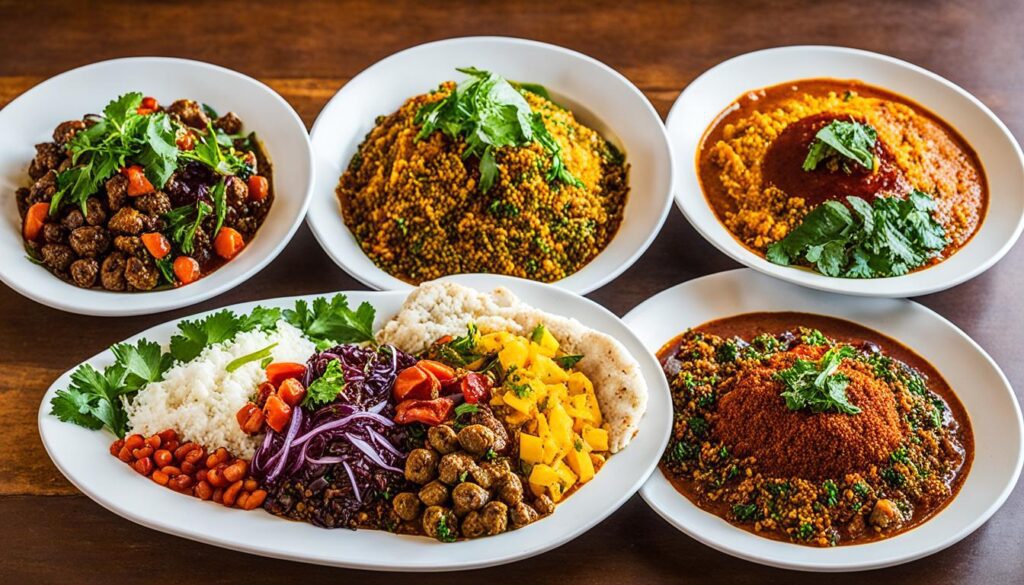
One cannot discuss Ethiopian food without mentioning injera. This unique sourdough flatbread acts as both a serving vessel and an essential part of the meal. Made from fermented teff flour, injera is not only a cultural staple but also contributes to the caloric content of Ethiopian cuisine.
Doro Wat: A Spicy Chicken Stew
Another favorite among Ethiopian food enthusiasts is doro wat. This fiery chicken stew packed with aromatic spices like berbere is a must-try for those who enjoy bold flavors. However, it’s important to note that the use of oil and butter in its preparation can contribute to its calorie count.
Kitfo: A Flavorful Ethiopian Beef Dish
If you’re a fan of beef, then kitfo should be on your radar. This traditional Ethiopian dish consists of minced raw or rare beef mixed with spices and served with injera. Due to the fatty nature of the beef and the added butter, kitfo is known for its indulgent flavors and higher calorie content.
Vegetarian Delights: Filling and Flavorful
Ethiopian cuisine also offers a variety of vegetarian options that are both filling and flavorful. Lentil stews, such as misir wat, and vegetable dishes, like gomen, showcase the vibrant diversity of flavors that can be found in Ethiopian cooking. These vegetarian delights generally have a lower calorie count compared to their meat counterparts.
By being aware of the caloric content of popular Ethiopian dishes like injera, doro wat, and kitfo, you can make conscious choices that align with your nutritional goals. It’s essential to enjoy the rich flavors of Ethiopian cuisine while keeping an eye on your caloric intake.
Balancing Ethiopian Food in a Healthy Diet
While Ethiopian food offers a wealth of flavors and textures, it’s important to maintain a balanced diet. Incorporating Ethiopian cuisine into a healthy eating plan can be an exciting and delicious way to nourish your body. At the same time, it’s essential to consider your caloric intake and nutritional needs to ensure optimal health.
When enjoying Ethiopian cuisine, portion sizes play a crucial role. Watch your serving sizes to avoid overeating, as some dishes may be higher in calories than others. It’s all about finding a balance that works for you and your dietary goals.
Tip: Start by filling half of your plate with vibrant, nutrient-rich vegetables commonly found in Ethiopian cuisine, such as collard greens, lentils, and cabbage. These vegetables are packed with essential vitamins and minerals to support your overall well-being.
Additionally, you can make healthier choices by opting for grilled or baked meats instead of fried ones. This reduces the intake of unhealthy fats while still savoring the authentic flavors of Ethiopian dishes.
Tip: If you’re following a vegetarian or plant-based diet, Ethiopian cuisine offers plenty of options. Injera, the sourdough flatbread, can be a great base for various vegetarian stews and dishes. Explore lentil, chickpea, and vegetable stews to experience the diversity of flavors Ethiopian cuisine has to offer.
Another way to balance Ethiopian food in a healthy diet is to consider ingredient alternatives. For example, instead of using excessive amounts of oil or butter, you can use flavorful herbs and spices to enhance the taste. This not only reduces calorie intake but also adds a burst of aromatic flavors to your meals.
Substitute Ingredients:
1. Replace butter with olive oil or avocado oil.
2. Use Greek yogurt as a healthier alternative to sour cream.
3. Experiment with different spices and herbs, such as turmeric, cumin, and cardamom, to add depth and complexity to your dishes.
By making these simple adjustments, you can enjoy the rich and diverse flavors of Ethiopian cuisine while still maintaining a healthy diet. Remember, it’s all about finding the right balance and listening to your body’s needs.
Conclusion
In conclusion, Ethiopian food offers a delightful blend of flavors and textures that make it a truly unique culinary experience. By understanding the caloric content of Ethiopian cuisine, you can make informed choices that align with your health goals. Whether you prefer the spicier dishes that tantalize your taste buds or the lighter vegetarian options that cater to your dietary preferences, exploring Ethiopian food can be a delicious and nutritious journey.
From the savory stews and aromatic spices to the nutritious teff-based injera, Ethiopian dishes showcase the cultural heritage and diversity of the country. While some traditional dishes may be higher in calories due to the use of oil and butter, there are also numerous lighter options that offer a healthier alternative. The nutritional profile of Ethiopian food, with its emphasis on complex carbohydrates, proteins, and healthy fats, contributes to a well-rounded and balanced diet.
So, the next time you’re craving a culinary adventure, consider trying Ethiopian cuisine. Not only will you indulge in a wide array of flavors, but you’ll also discover a new appreciation for the caloric content of the dishes you savor. By making mindful choices and paying attention to portion sizes, you can enjoy the rich traditions and vibrant flavors of Ethiopian food while maintaining a healthy lifestyle.

